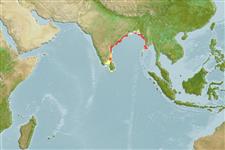Actinopterygii (ray-finned fishes) >
Clupeiformes (Herrings) >
Engraulidae (Anchovies) > Coiliinae
Etymology: Thryssa: Greek, thrissa, -es = shad (Ref. 45335).
Environment / Climate / Range
Ecology
Marine; brackish; pelagic-neritic; amphidromous (Ref. 51243); depth range 0 - 50 m (Ref. 189). Tropical, preferred ?; 25°N - 4°N, 76°E - 95°E (Ref. 189)
Indian Ocean: eastern coasts of India, possibly also Myanmar.
Size / Weight / Age
Maturity: Lm ? range ? - ? cm
Max length : 21.5 cm SL male/unsexed; (Ref. 189)
Dorsal
spines
(total): 0;
Anal
spines: 0;
Anal
soft rays: 34 - 37. Belly with 25 to 27 (rarely 24) keeled scutes from isthmus to anus. Tip of snout at about level of upper rim of eye. Maxilla moderate, projecting slightly beyond edge of gill cover; first supra-maxilla minute, oval; jaw teeth slightly enlarged compared with other species. A dark blotch behind upper part of gill opening; a pair of dark lines on back, from nape to caudal fin.
Presumably schooling, occurring mostly inshore and entering estuaries. More data needed.
Life cycle and mating behavior
Maturity | Reproduction | Spawning | Eggs | Fecundity | Larvae
Whitehead, P.J.P., G.J. Nelson and T. Wongratana, 1988. FAO Species Catalogue. Vol. 7. Clupeoid fishes of the world (Suborder Clupeoidei). An annotated and illustrated catalogue of the herrings, sardines, pilchards, sprats, shads, anchovies and wolf-herrings. FAO Fish. Synop. 125(7/2):305-579. Rome: FAO. (Ref. 189)
IUCN Red List Status (Ref. 115185)
CITES (Ref. 94142)
Not Evaluated
Threat to humans
Harmless
Human uses
Fisheries: subsistence fisheries
More information
Common namesSynonymsMetabolismPredatorsEcotoxicologyReproductionMaturitySpawningFecundityEggsEgg development
ReferencesAquacultureAquaculture profileStrainsGeneticsAllele frequenciesHeritabilityDiseasesProcessingMass conversion
Tools
Special reports
Download XML
Internet sources
Estimates of some properties based on models
Phylogenetic diversity index (Ref.
82805): PD
50 = 0.5000 [Uniqueness, from 0.5 = low to 2.0 = high].
Bayesian length-weight: a=0.00407 (0.00172 - 0.00965), b=3.04 (2.83 - 3.25), in cm Total Length, based on LWR estimates for this (Sub)family-body shape (Ref.
93245).
Trophic Level (Ref.
69278): 3.3 ±0.5 se; Based on size and trophs of closest relatives
Resilience (Ref.
69278): High, minimum population doubling time less than 15 months (Preliminary K or Fecundity.).
Vulnerability (Ref.
59153): Low to moderate vulnerability (28 of 100) .
